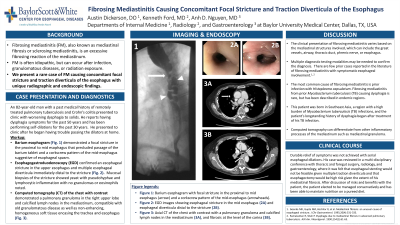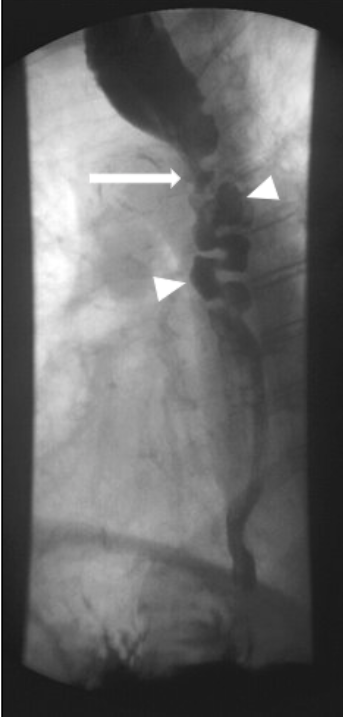Tuesday Poster Session
Category: Esophagus
P3326 - Fibrosing Mediastinitis Causing Concomitant Focal Stricture and Traction Diverticula of the Esophagus
Tuesday, October 24, 2023
10:30 AM - 4:00 PM PT
Location: Exhibit Hall

Has Audio

Austin Dickerson, DO
Baylor University Medical Center
Dallas, TX
Presenting Author(s)
Austin Dickerson, DO1, Kenneth Ford, MD1, Anh D.. Nguyen, MD2
1Baylor University Medical Center, Dallas, TX; 2Center for Esophageal Diseases, Baylor University Medical Center, Dallas, TX
Introduction: Fibrosing mediastinitis, also known as mediastinal fibrosis or sclerosing mediastinitis, is a rare condition caused by an excessive fibrosing reaction of the mediastinum. The clinical presentation of fibrosing mediastinitis varies based on the mediastinal structures involved, which can include the great vessels, airway, thoracic duct, phrenic nerve, or esophagus. We present a unique case of a patient with fibrosing mediastinitis causing dysphagia due to esophageal involvement with both focal esophageal stricture and multiple traction diverticula.
Case Description/Methods: 82-year-old man with a past medical history of treated pulmonary tuberculosis in his 20s, Crohn’s colitis and gastroesophageal reflux disease presented to clinic with worsening dysphagia for the past few years with chronic dysphagia symptoms for the past 50 years. Barium esophagram demonstrated a stricture in the upper to mid esophagus and a corkscrew pattern of the mid-esophagus (Figure 1). Esophagogastroduodenoscopy demonstrated an esophageal stricture and multiple traction diverticula distal to the stricture. Computed tomography of the chest showed homogeneous soft tissue encasing the trachea and esophagus consistent with fibrosing mediastinitis. Serial dilation of the esophageal stricture was performed, but mucosal disruption was never achieved with no improvement in stricture diameter. The case was discussed in a multi-disciplinary conference where esophageal stenting was not felt to be feasible given multiple traction diverticula, and esophageal resection would be high risk given the fibrosing mediastinitis. Risks and benefits were discussed with the patient, and the patient opted to do dietary modifications as he did not have dysphagia on a pureed diet.
Discussion: Fibrosing mediastinitis is often idiopathic but can be due to infectious/inflammatory processes, sarcoidosis, or radiation exposure. The most common cause of fibrosing mediastinitis is prior infection with Histoplasma capsulatum. In this case, fibrosing mediastinitis from remote Mycobacterium tuberculosis infection resulted in a focal stricture and traction diverticula of the esophagus causing dysphagia. Barium esophagram revealed a corkscrew pattern of the esophagus, a pattern usually seen in diffuse esophageal spasm but was due to multiple traction diverticula. Fibrosing mediastinitis causing dysphagia is rare, and no prior reports in the literature describe a case causing concomitant esophageal stricture and traction diverticula in a patient.

Disclosures:
Austin Dickerson, DO1, Kenneth Ford, MD1, Anh D.. Nguyen, MD2. P3326 - Fibrosing Mediastinitis Causing Concomitant Focal Stricture and Traction Diverticula of the Esophagus, ACG 2023 Annual Scientific Meeting Abstracts. Vancouver, BC, Canada: American College of Gastroenterology.
1Baylor University Medical Center, Dallas, TX; 2Center for Esophageal Diseases, Baylor University Medical Center, Dallas, TX
Introduction: Fibrosing mediastinitis, also known as mediastinal fibrosis or sclerosing mediastinitis, is a rare condition caused by an excessive fibrosing reaction of the mediastinum. The clinical presentation of fibrosing mediastinitis varies based on the mediastinal structures involved, which can include the great vessels, airway, thoracic duct, phrenic nerve, or esophagus. We present a unique case of a patient with fibrosing mediastinitis causing dysphagia due to esophageal involvement with both focal esophageal stricture and multiple traction diverticula.
Case Description/Methods: 82-year-old man with a past medical history of treated pulmonary tuberculosis in his 20s, Crohn’s colitis and gastroesophageal reflux disease presented to clinic with worsening dysphagia for the past few years with chronic dysphagia symptoms for the past 50 years. Barium esophagram demonstrated a stricture in the upper to mid esophagus and a corkscrew pattern of the mid-esophagus (Figure 1). Esophagogastroduodenoscopy demonstrated an esophageal stricture and multiple traction diverticula distal to the stricture. Computed tomography of the chest showed homogeneous soft tissue encasing the trachea and esophagus consistent with fibrosing mediastinitis. Serial dilation of the esophageal stricture was performed, but mucosal disruption was never achieved with no improvement in stricture diameter. The case was discussed in a multi-disciplinary conference where esophageal stenting was not felt to be feasible given multiple traction diverticula, and esophageal resection would be high risk given the fibrosing mediastinitis. Risks and benefits were discussed with the patient, and the patient opted to do dietary modifications as he did not have dysphagia on a pureed diet.
Discussion: Fibrosing mediastinitis is often idiopathic but can be due to infectious/inflammatory processes, sarcoidosis, or radiation exposure. The most common cause of fibrosing mediastinitis is prior infection with Histoplasma capsulatum. In this case, fibrosing mediastinitis from remote Mycobacterium tuberculosis infection resulted in a focal stricture and traction diverticula of the esophagus causing dysphagia. Barium esophagram revealed a corkscrew pattern of the esophagus, a pattern usually seen in diffuse esophageal spasm but was due to multiple traction diverticula. Fibrosing mediastinitis causing dysphagia is rare, and no prior reports in the literature describe a case causing concomitant esophageal stricture and traction diverticula in a patient.

Figure: Figure 1. Full column esophagram in the prone RAO position demonstrates a stricture of the mid thoracic esophagus at the level of the transverse thoracic aorta (arrow), with multiple fixed areas of narrowing alternating with traction diverticula in the mid thoracic esophagus at the level of the pulmonary hila (arrowheads)
Disclosures:
Austin Dickerson indicated no relevant financial relationships.
Kenneth Ford indicated no relevant financial relationships.
Anh Nguyen indicated no relevant financial relationships.
Austin Dickerson, DO1, Kenneth Ford, MD1, Anh D.. Nguyen, MD2. P3326 - Fibrosing Mediastinitis Causing Concomitant Focal Stricture and Traction Diverticula of the Esophagus, ACG 2023 Annual Scientific Meeting Abstracts. Vancouver, BC, Canada: American College of Gastroenterology.

